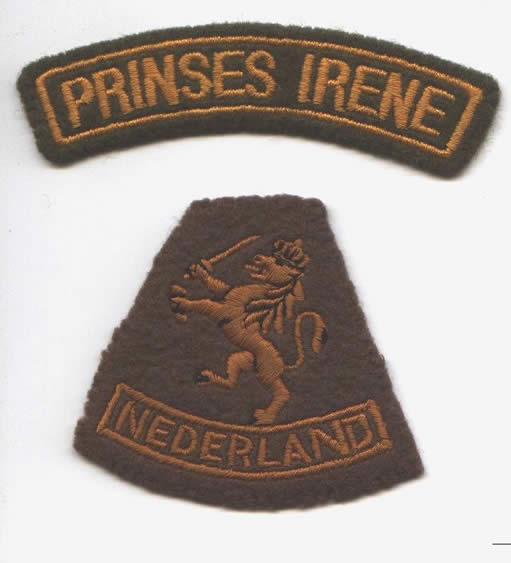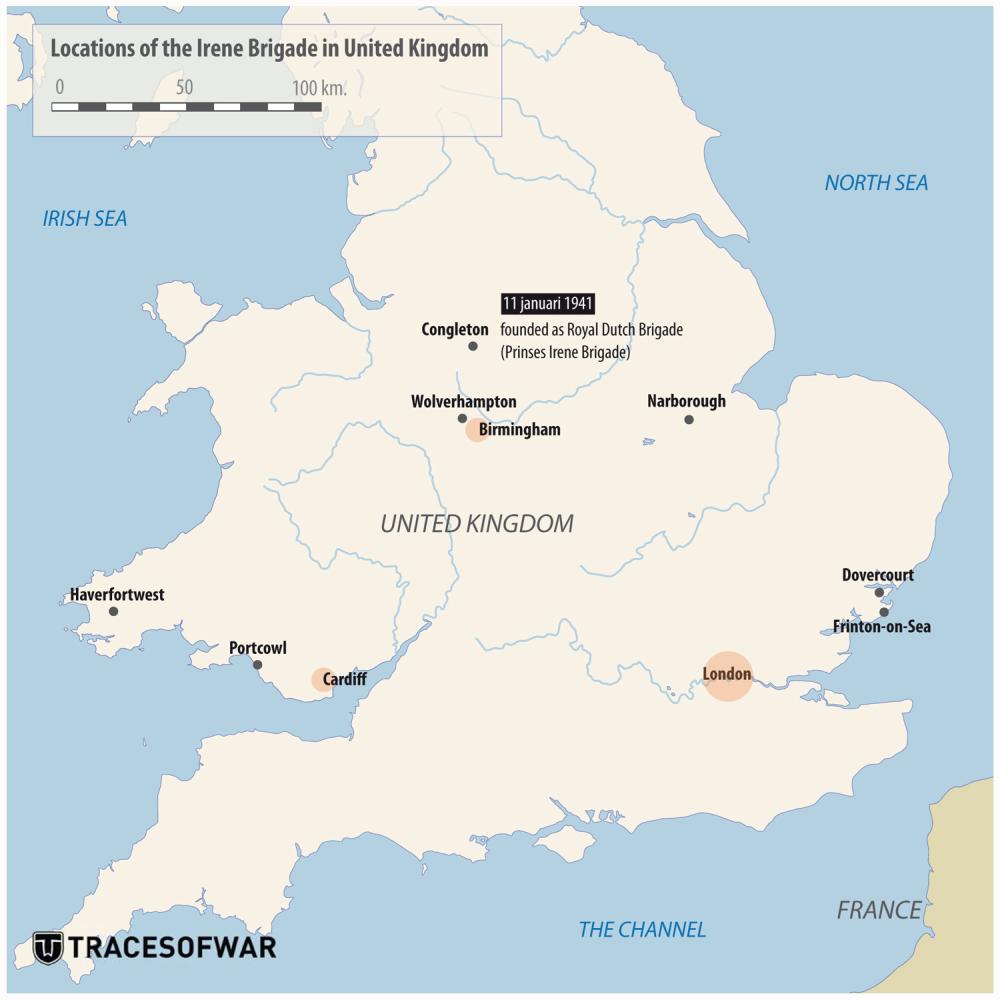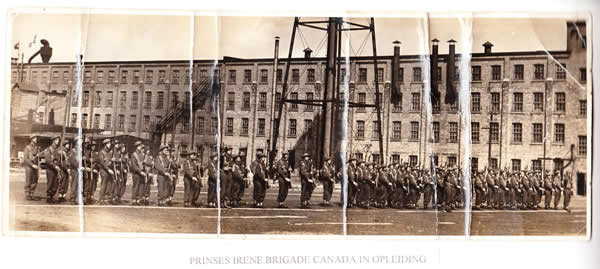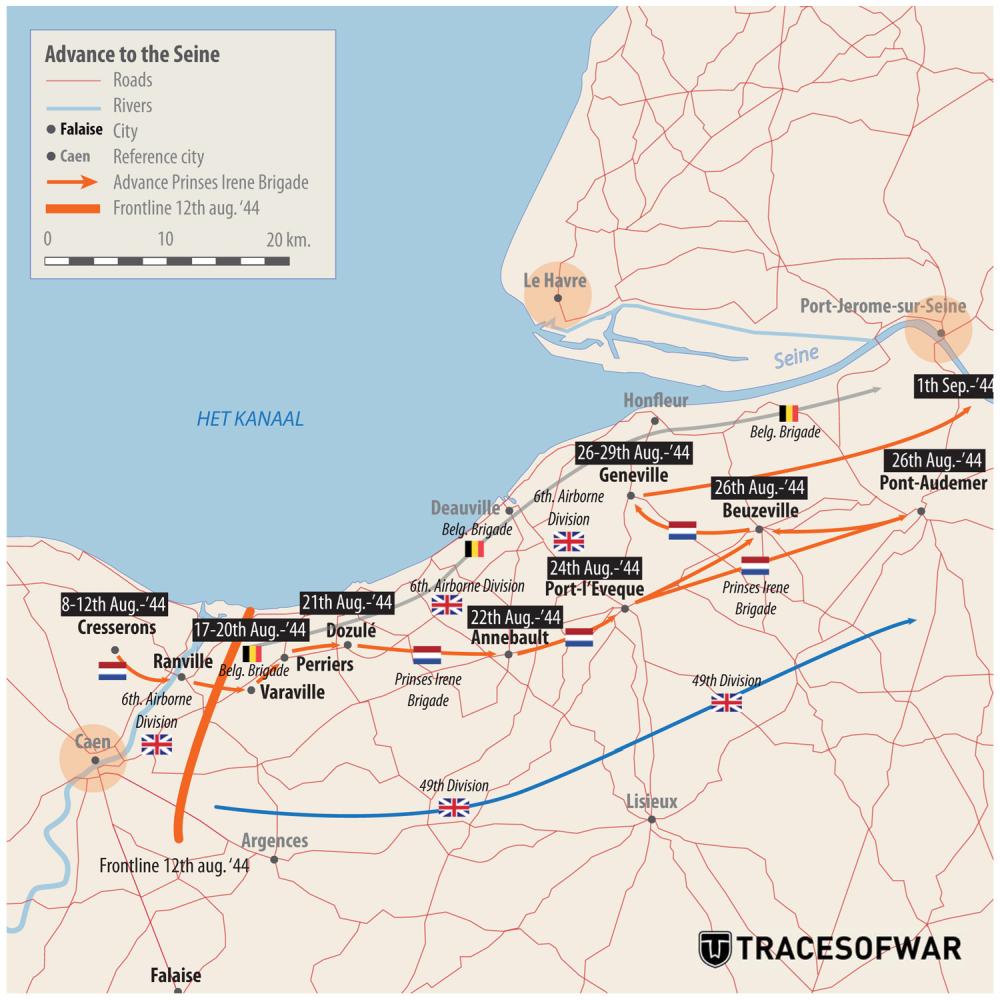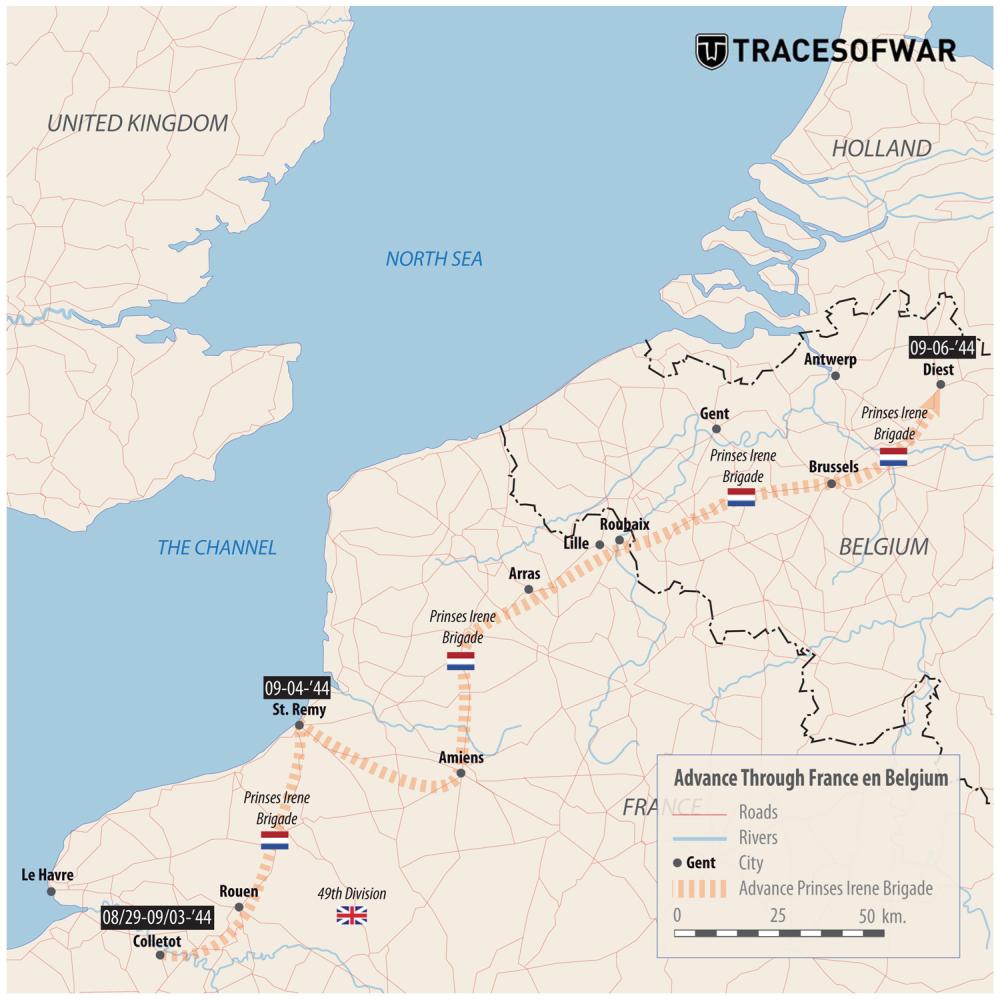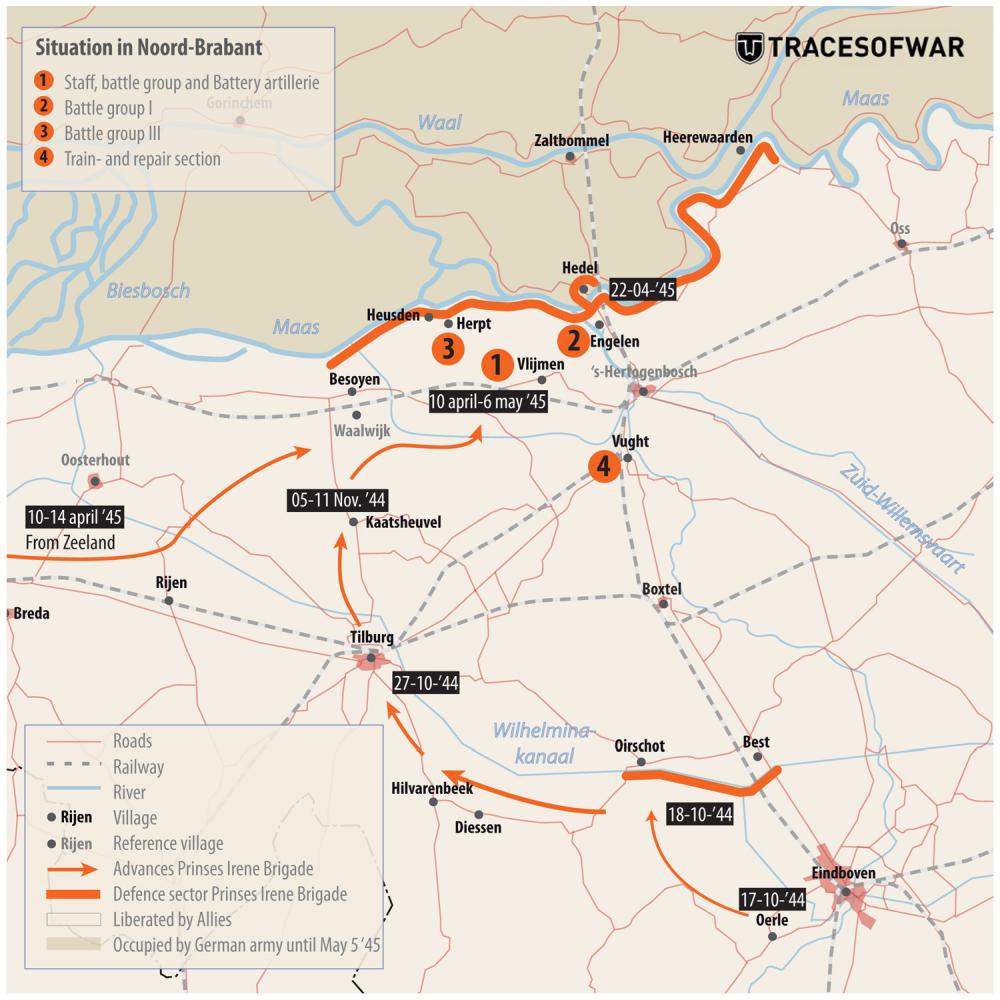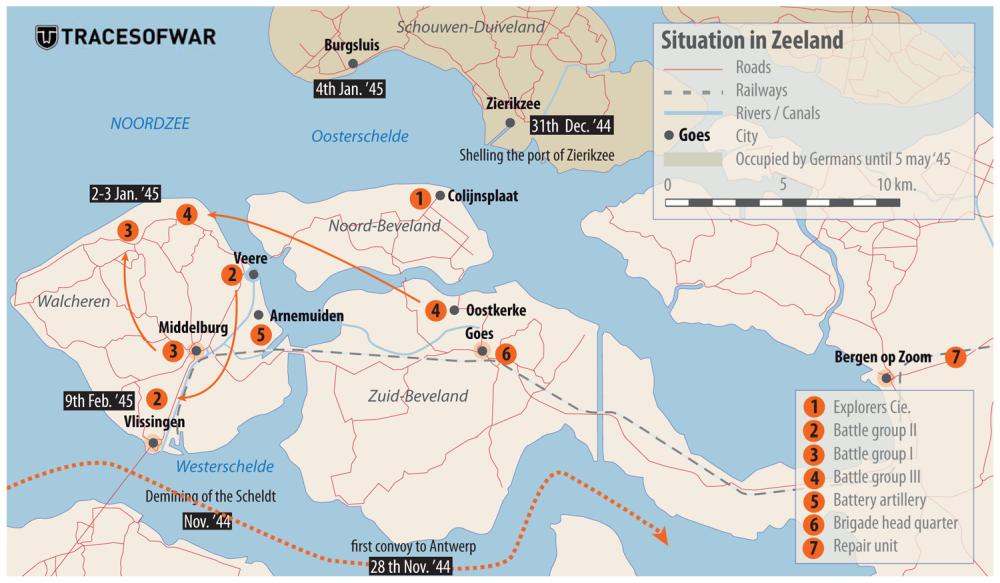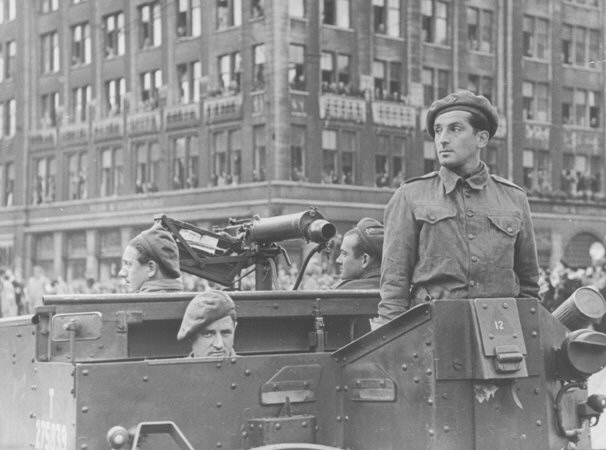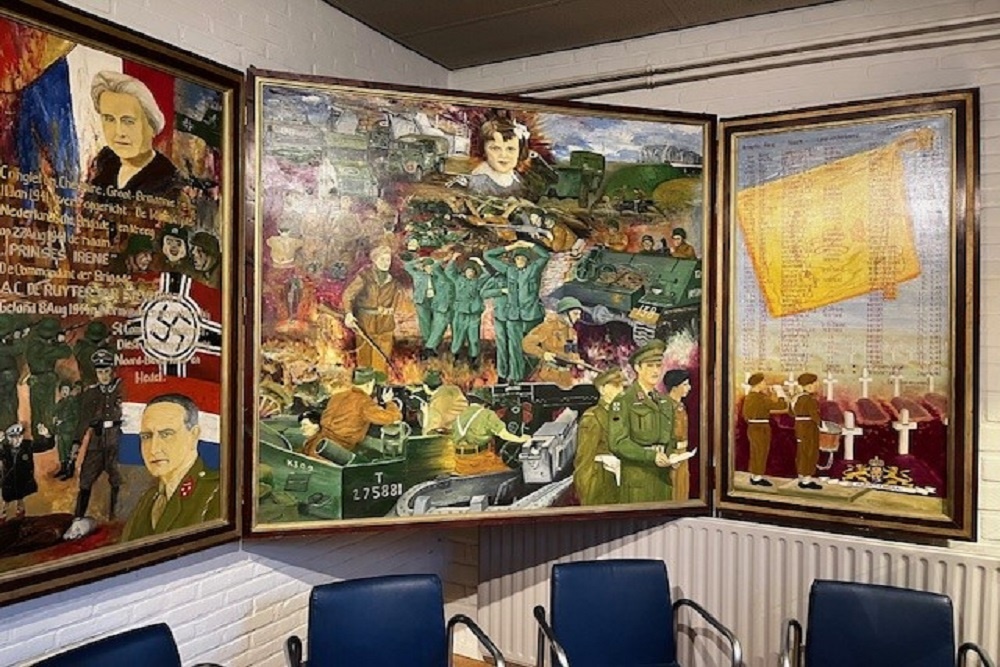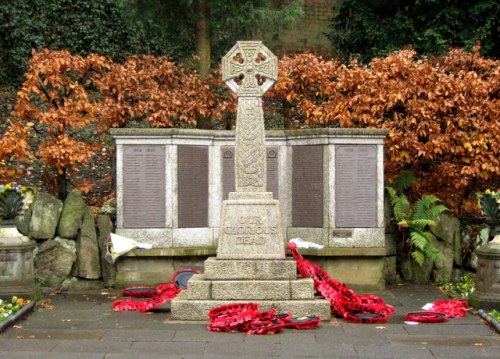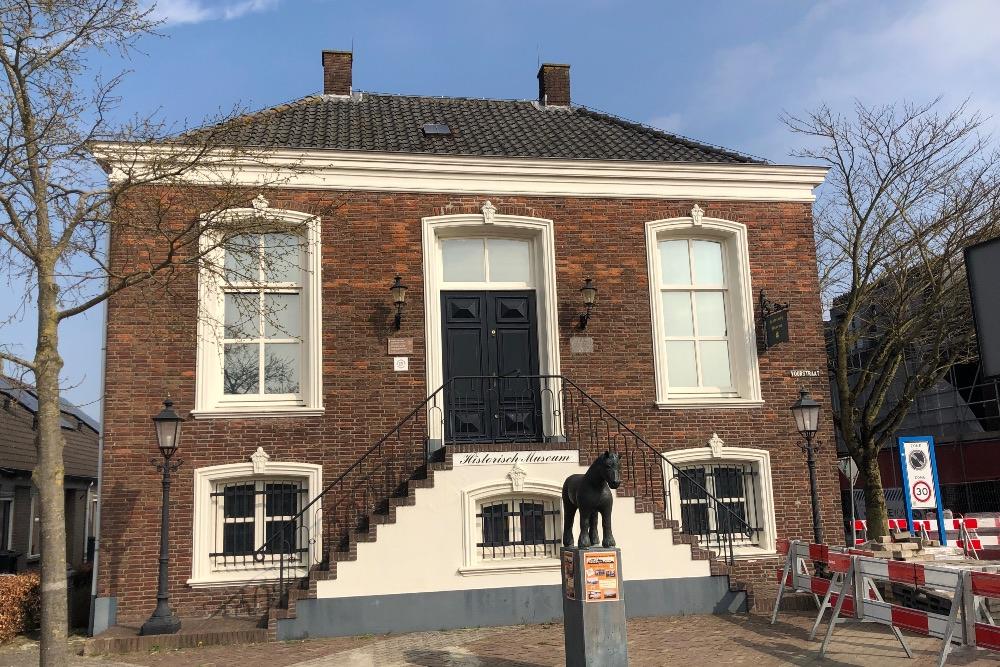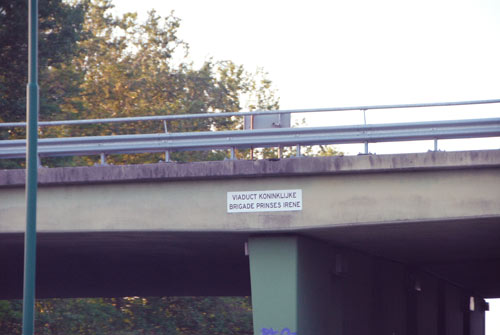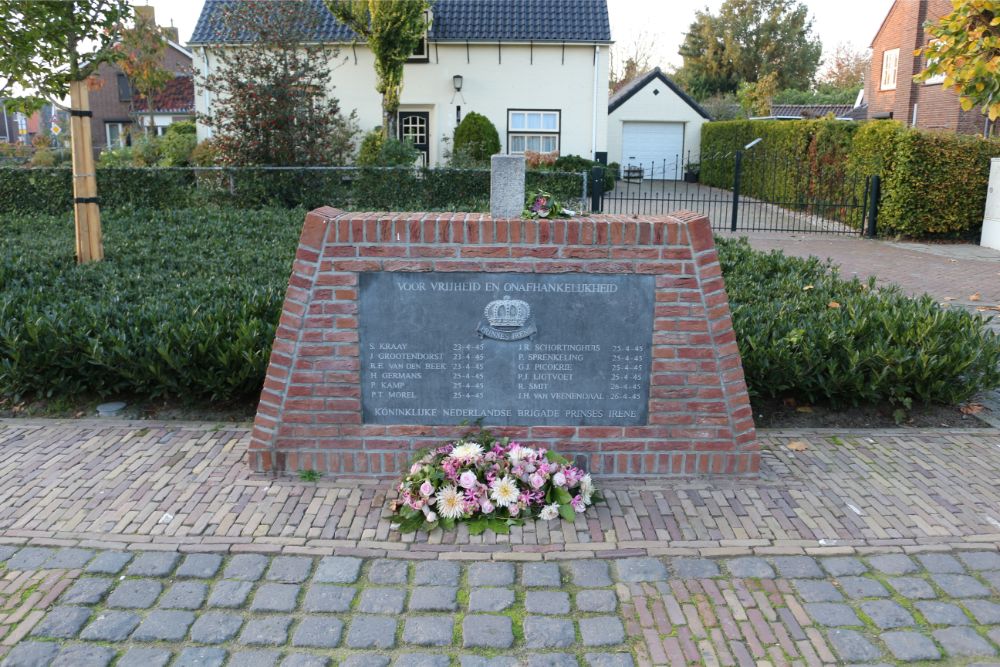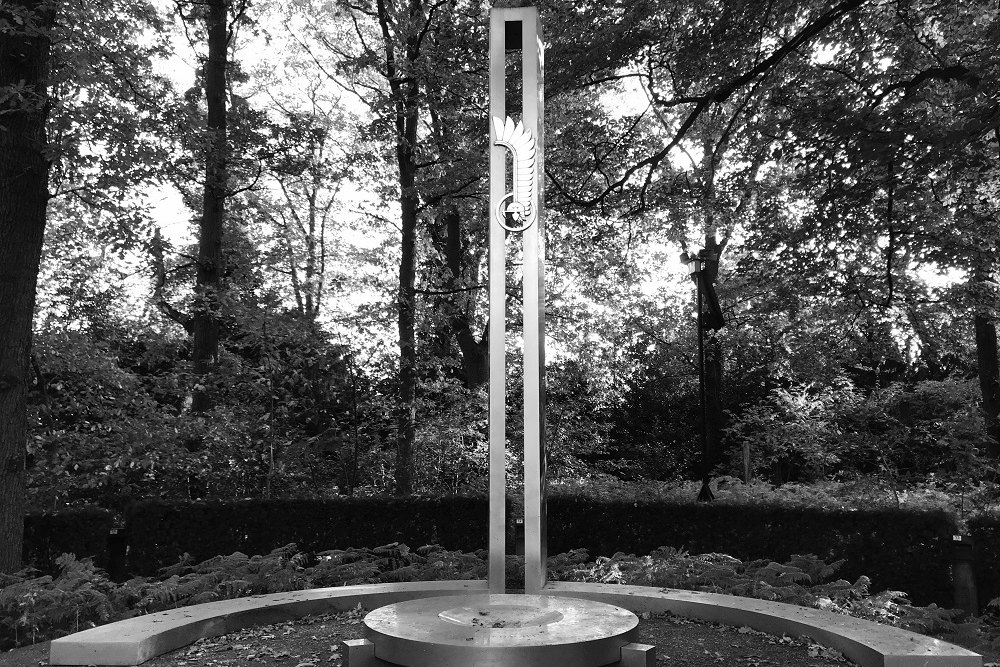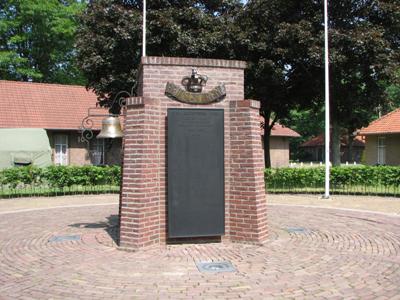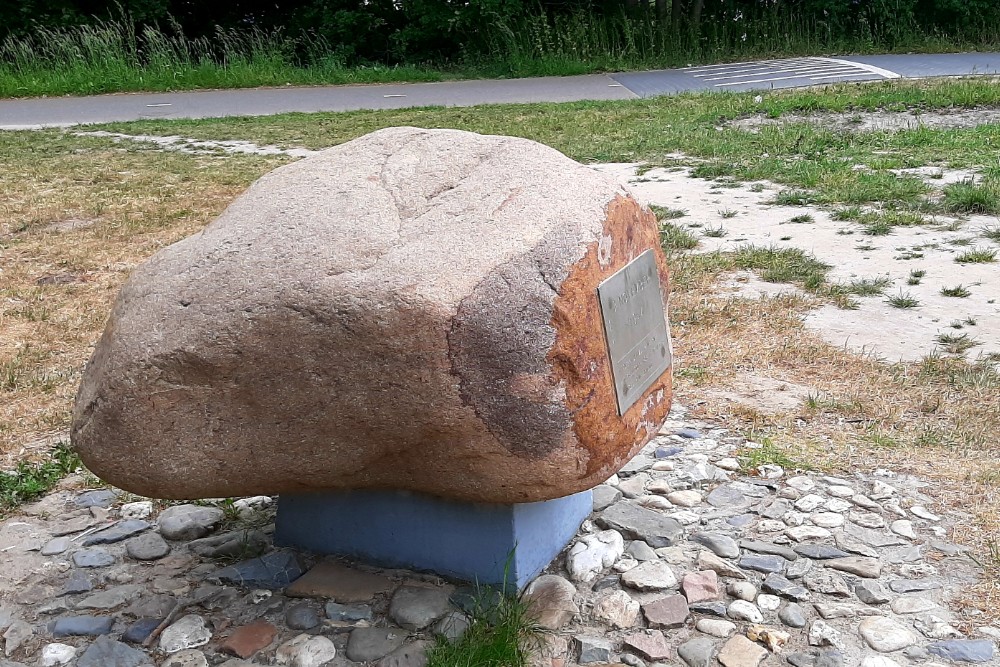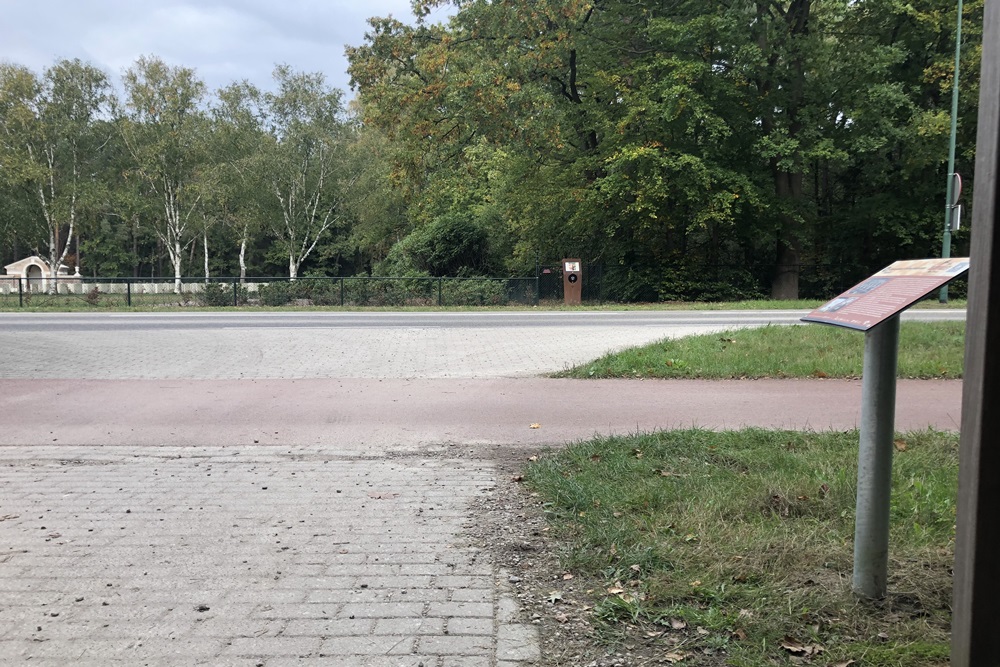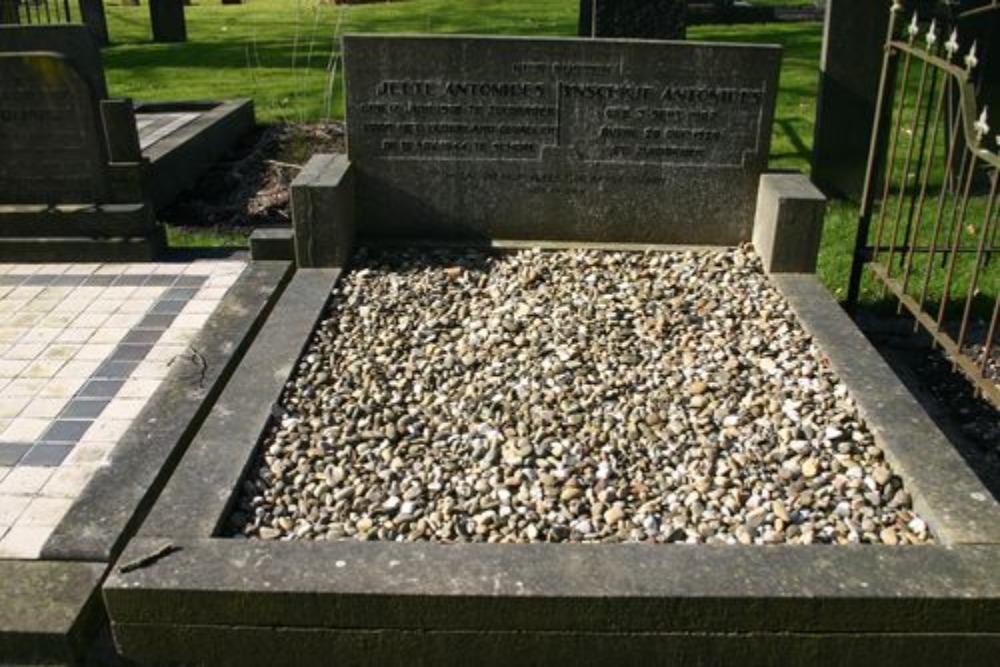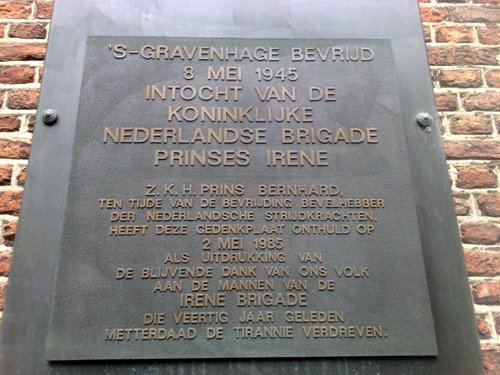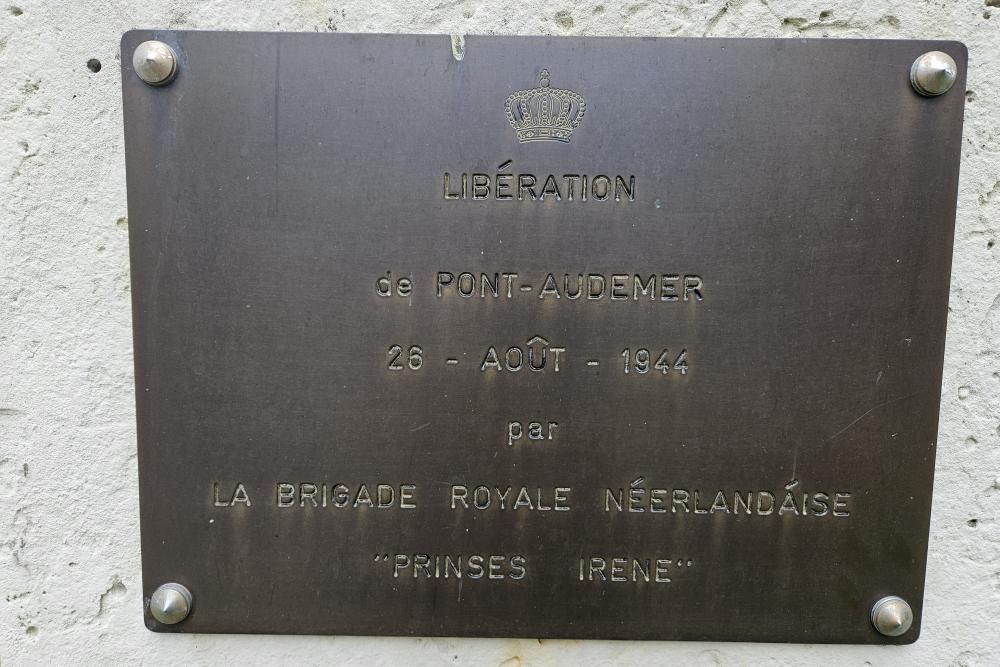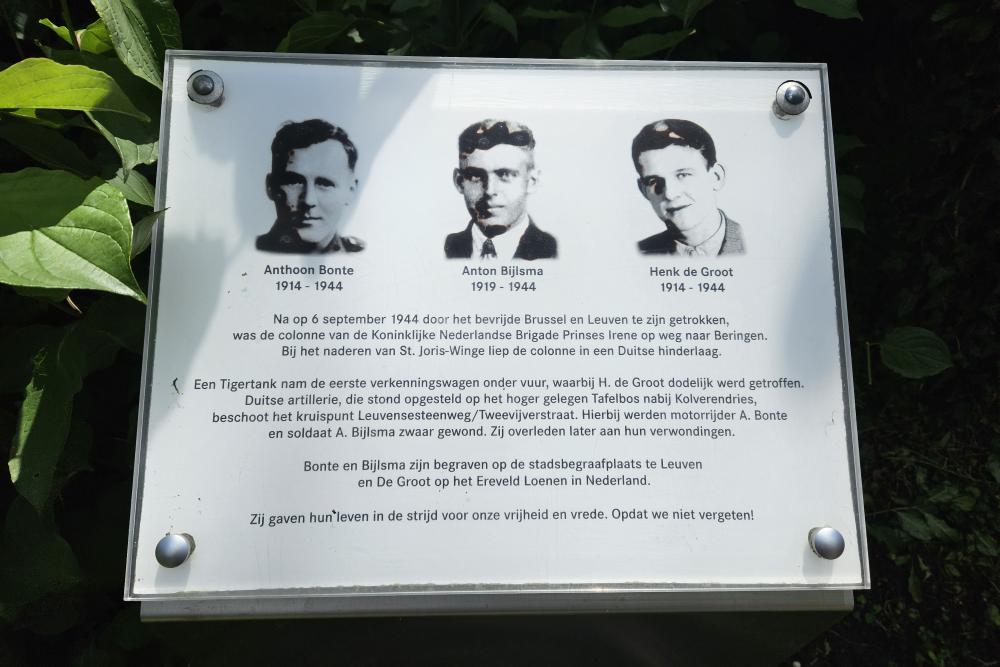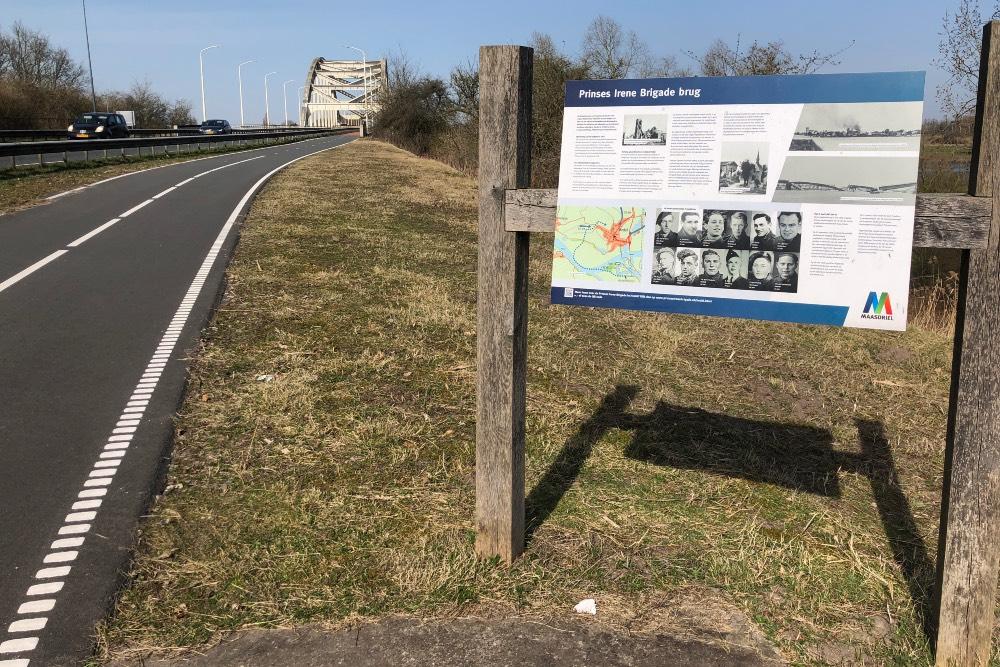Start and training
On May 14, 1940, after the German Operation "Fall Gelb" the Netherlands surrendered to Germany with the exception of the south westerly province of Zeeland. From the Netherlands only a few military succeeded in escaping to Great Britain. When the battle was also lost in Zeeland, a large number of soldiers escaped to Great Britain via the Belgian and French ports Brest and Cherbourg. Next to troops of the regular forces, part of the ground personnel of the flying schools Haamstede and Flushing succeeded in fleeing to Great Britain.
Finally 120 officers, 360 non-commissioned officers and 980 corporals and soldiers derived from all kinds of units had arrived in Great Britain up till June 1940. The British encamped them near Haverfordwest and near Portcawl, under the command of General-Major Noothoven van Goor from 23 May onwards. This Dutch group was called "Detachment Royal Netherlands’ Troops in Great Britain" [Detachment Koninklijke Nederlandse Troepen in Groot-Britannië] and her commander in chief was named "Inspector of Dutch Troops" [Inspecteur der Nederlandse troepen] . On June 30th 133 men were selected from this group and transferred to the RAF and the flight crews were transferred to the Dutch East Indies and detached with the Naval Air Force’s 320 (Dutch) Squadron.
After a period of uncertainty the group was armed, supplied with uniforms and clothing and was charged with guard duties. End July Prince Bernhard of the Netherlands visited the troops and the Dutch Government (in exile) started to make plans to establish a Dutch unit. It was decided that in any case the number of people in military service had to be increased significantly. On 27 May all Dutchmen between 20 and 35 years of age and living in Great Britain were called up. On the 8th of August also Dutchmen living in Northern Ireland, Canada and the United States were called up and later on also those living in South Africa and other countries. Volunteers from other countries could report but were just registered and only in a later stage ferried to England.
The number of people that became available for active service was disappointingly low because a number of Dutchmen volunteered for the American and Canadian armies, a significant number was sent to the Dutch Indies and a part succeeded in withdrawing from active duties. Next to that, a large number of people was simply not fit for service or was not available for active service because they were not healthy or received remission in one way or the other. Also a German U-boat succeeded in torpedoing a ship with 392 passengers and crew amongst whom 59 recruits, 1 member of the Prinses Irene Brigade and 33 Dutch naval personnel.
Of all personnel that became available in Great Britain, only a limited number could be enlisted in the regular Army [Koninklijke Landmacht] because part of them was placed with the Navy [Koninklijke Marine] and Air Force [Koninklijke Luchtmacht]. Next to that, also the Government in Exile required personnel. Towards the end of the year the Government in Exile decided to establish a Brigade.
On January 11th 1941 the Brigade was officially established and received the name "Royal Dutch Brigade" [Koninklijke Nederlandse Brigade] and would consist of a staff and two battalions in accordance with the British organization structure. End January an armored unit was added which contained a large content of the Royal Constabulary [Koninklijke Marechaussee] . In May 1941 the first units could be moved from the temporary camp to their definitive barracks in Wrottesleypark, at 4 kilometers from Wolverhampton. The Brigade Commander Colonel of the Infantry H.J. Phaff also became the camp commander with a different staff.
In August 1941 the Brigade consisted of a staff, a communications unit, two battalions, a depot (out of which the 3rd battalion had to be formed) a brigade supply train, medical support post, a repair unit and a section military police. The armored unit in the meantime had been dissolved again. By Royal Decree Nr. 1 dated 26 August, 1941, the Brigade was called "Koninklijke Nederlandse Brigade Prinses Irene". [The brigade has been named after Her Royal Highness Princess Irene of the Netherlands, born in Soestdijk on August 5, 1939, as the second daughter of Princess Juliana and Prince Bernhard of the Netherlands and is sometimes called briefly "the Irene Brigade" or "the Brigade". FB]
The strength of the troops was diminished between 1 September 1941 and 13 April 1942 with 48 officers, 76 non-commissioned officers and 395 corporals and soldiers. Reasons for the decrease in strength were the establishing of 322 (Spitfire) Squadron and participation in the Nr 10 Interallied Commando and the SAS. Also troops had been sent to Suriname and Ceylon. Finally 1.300 men remained of whom 900 were fit for battle service. In 1942 it appeared to be necessary to develop an organization of 1.000 men which would serve as the basis for the, to be newly set up, forces in the Netherlands after the war.
Halfway 1942 the command of the Brigade was taken over by Lieutenant-Colonel of the Artillery A.C. de Ruyter van Steveninck. On 16 December 1942 the Minister of War (in Exile) visited the Brigade with the announcement that reorganization would have to be carried out and a totally motorized brigade would be created. This reorganization was realized on 1 January 1943 and the name Brigade was maintained, even though the organization was different. Now the Brigade consisted of the following units: staff, scouting unit, three independent companies (called battle groups) an artillery battery, a train and a repair unit. The Brigade was regularly exercised and in 1943 participated in maneuvers also in combination with British units and on different locations.
In the course of 1943, XXI Army Corps was established under General Bernard Montgomery including the 1st Canadian Army and the 2nd British Army. The Prinses Irene Brigade was joined with this group and charged with coastal guard duties in Dovercourt and Frinton-on-sea.
After inspection by the British it was correctly established that the Brigade was not up to strength and was reinforced with a group of marines that was being trained in the United States. They were added to the Brigade and joined the 2nd battle group till the end of the war. Now the Prinses Irene Brigade complied with the British requirements.
During Operation Overlord on June 6th 1944, the Irene Brigade was still in charge of coastal guard duties. End June they were transferred to a tent camp near Narborough where maneuvers were held in a larger context, amongst others with the Belgian Brigade. The Irene Brigade was preparing to be transferred to the mainland and was completely isolated from the outside world because of security reasons. All equipment and armament was thoroughly checked and where necessary, replaced. French money and 24-hours-rations were distributed. The Prinses Irene Brigade was prepared and ready to go for it.
Definitielijst
- Brigade
- Consisted mostly of two or more regiments. Could operate independently or as part of a division. Sometimes they were part of a corps instead of a division. In theory a brigade consisted of 5,000 to 7,000 men.
- Infantry
- Foot soldiers of a given army.
- RAF
- Royal Air Force. British air force
- Squadron
- A military unit in the Belgian navy usually six to eight small ships operating together under one command. The smallest military unit in the Dutch air force of about 350 men. In most countries is the designation of a military unit thesize of a company. It is either an independent unit, such as a battery, or part of a bigger Calvary unit. In the air force it is the designation of a unit of aircrafts.
- U-boat
- The German name for a submarine. German U-Boats (Submarines) played a very important role during the course of warfare until May 1943. Many cargo and passenger ships were torpedoed and sunk by these assassins of the sea.
Images
Organization, armament and personnel
Overview of armament and personnel of the Prinses Irene Brigade.
| Personnel | Staff | Scouting | 3 Battle Group* | Artill. | Comm. | Supply | Repair | Total |
| Officers | 16 | 7 | 33 | 4 | 1 | 1 | 2 | 64 |
| Non-com. Officers | 14 | 15 | 93 | 6 | 1 | 5 | 5 | 139 |
| Corporals and soldiers | 90 | 110 | 621 | 82 | 39 | 37 | 23 | 1002 |
| Totaal | 120 | 132 | 747 | 92 | 41 | 43 | 30 | 1205 |
| Armament | ||||||||
| Pistol | 14 | 7 | 33 | 4 | 1 | 1 | 2 | 62 |
| Rifle | 49 | 63 | 465 | 58 | 18 | 22 | 17 | 692 |
| Stengun | 52 | 39 | 210 | 28 | 21 | 20 | 10 | 380 |
| Brengun | 5 | 29 | 48 | 2 | 1 | 3 | 1 | 89 |
| Vickers MG | - | - | 12 | - | - | - | - | 12 |
| Piat | 5 | 6 | 21 | 2 | 1 | 3 | - | 38 |
| 50 mm mortar | - | 6 | 18 | - | - | - | - | 24 |
| 80 mm mortar | - | - | 6 | - | - | - | - | 6 |
| Gun AA (20 mm) | 3 | - | 6 | - | - | - | - | 9 |
| Anti tank gun (6 lbs) | 2 | 6 | - | - | - | - | 8 | |
| Gun (25 lbs) | - | - | - | 4 (6) | - | - | - | 4 (6) |
| Signalgun | - | 12 | - | 2 | - | - | - | 14 |
| Hand grenade | - | ? | 1380 | 24 | 12 | - | 12 | 1428 |
*Battle Group = the three Battle Groups together.
Definitielijst
- mortar
- Canon that is able to fire its grenades, in a very curved trajectory at short range.
- Piat
- Projector Infantry Anti-Tank. British anti-tank weapon, used by infantry troops. It has the shape of a rifle and is based on the rifle principle. A PIAT can be reloaded.
Images
Advance towards the river Seine
The Irene Brigade left for Normandy on 6 August 1944, together with the 1st Belgian Brigade on August 6th, 1944. They disembarked at different locations. The Battle Groups arrived at the artificial harbor at Arromanches, the so called Mulberry port. The other units were put ashore at Courseuilles sur Mer with landing crafts. On August 8, the Brigade arrived at Cresserons and stayed till August 12. They were, like the 1st Belgian Brigade, incorporated in the British 6th Airborne Division which was encamped just east of the river Orne, under Richard Gale.
Before an offensive started, the Irene Brigade on 12 August took over a section of 1 kilometer of the frontline east of Breville. This part had earlier been occupied by the Royal Ulster Rifles and on its opposite site were German units of the 744. Grenadieregiment. After the taking over of the frontline from time to time there were artillery barrages which resulted in casualties and on August 14th, the first soldier was killed. The artillery battery was incorporated in the 53rd Airborne Artillery Regiment and positioned north of Ranville and later on near Bénauville. The 2nd Battle Group later on was charged with guard duties in Ouistreham.
The German troops in Normandy had become surrounded and stuck near Falaise on 20 August 1944 after a bloody battle from which only one third had succeeded to escape and they had left behind all heavy armament. The allies launched an offensive in order to pursue the German troops on their flight to the river Seine. The Irene Brigade had to advance along the coast together with the 6th Airborne Division as part of this offensive towards the Seine.
In the early morning of 17 August the advance started in the direction of Varaville and the Brigade succeeded quite easily in capturing the undermined German positions, where they stayed for several days. The 3rd Para Brigade, advancing south of the Irene Brigade, met heavy resistance half way the road to Dozulé, after which three days of failing attacks followed. The Prinses Irene Brigade stayed in their positions till August 20th ; consequently they liberated Varaville and reached Perriers on August 21. In the meantime the Germans had withdrawn from Dozulé and the 3rd Para Brigade captured this village after which the fighting developed around Annebault and the Germans also there withdrew. The Irene Brigade had been ordered to advance from Dozulé and Annebault towards a place south west of Pont l’Evèque and to camp there for two days. During this encampment, Prince Bernhard visited the Brigade on 22 August.
On 24 August the Irene Brigade was placed under the command of the British 5th Para Brigade and left for Pont l’Evèque, after which Battle Groups 1 and 3 formed the southern flank of the 5th Para Brigade. An opportunity was created to advance quickly to Pont Audemer and to capture the bridge and thus to cut off the retreat of the Germans. A commando group was composed from the Scouting Unit, Battle Group 1, boarded on top of the tanks of the Reconnaissance Unit of the 6th Airborne Division and Battle Group 3, carried on light vehicles. In the early morning of the 26th they advanced towards Beuzeville where it appeared that their hopes to surround the German units had vanished. The Germans had withdrawn behind the Seine, leaving behind a rearguard of small units. The commando group was ordered to progress immediately towards Pont Audemer and succeeded to occupy this place. Some German units had dug in on a slight hill at the opposite side of the river and opened fire on the town.
By nightfall the 49th Division reached the city and took over the occupation. The Irene Brigade and the 5th Para Brigade were sent to Genneville. They stayed there from 26 till 29 August after which they were transferred to Colletot where they stayed from 29 August till 3 September. Because of the return of the 6th Airborne Division to Great Britain, the Prinses Irene Brigade was placed under command of the British 49th Division. The artillery battery was joined with 185th Field Artillery Regiment Royal Artillery of the 49th Division and was provided with two artillery guns and the required supporting vehicles.
The Irene Brigade was charged with guarding the river Seine in its sector and received orders to cross patrols in order to scout the opposite bank and if possible to take prisoners. On 30 and 31 August successful patrols were carried out with the assistance of the French resistance. It appeared that the Germans withdrew further and were no longer on the river banks. On September 1 the order was issued to continue the advance and on September 2 the Seine was crossed. The Belgian Brigade would be pointed against Le Havre and the Irene Brigade would cross in the rearmost position.
Definitielijst
- Brigade
- Consisted mostly of two or more regiments. Could operate independently or as part of a division. Sometimes they were part of a corps instead of a division. In theory a brigade consisted of 5,000 to 7,000 men.
- offensive
- Attack on a smaller or larger scale.
- Regiment
- Part of a division. A division divided into a number of regiments. In the army traditionally the name of the major organised unit of one type of weapon.
- resistance
- Resistance against the enemy. Often also with armed resources.
Images
Belgium and Operation Market Garden
The allied advance towards the Seine River had progressed advantageously and the German forces had crossed the river with ferries because of the lack of bridges which had been destroyed by allied bombings. In doing so almost all heavy equipment had been left behind by the German troops.
The 2nd British Army had to advance to the Arras, Amiens and St.Pol area, across the Seine, after which progress towards Belgium would be made. The 1st Canadian Army had to advance along the coast to Bruges and in doing so destroy the V2 launching platforms and capturing the ports. The 2nd British Army moved forwards alongside the Canadians more inland and after a very advantageous advance they captured finally Brussels and the harbors of Antwerp almost undamaged.
On September 3, 1944, Prince Bernhard was appointed by the Dutch Government to be the supreme commander of the Dutch Forces. The Prinses Irene Brigade however remained operational under the command of the 21st British Army Group. The Brigade was to join the 2nd Canadian Army Group on September 3rd and was ordered to move to St.Rémy where they were assembled with the, up to that moment elsewhere operating, artillery battery. The Irene Brigade arrived on September 4th where she was assigned to the 30th Army Corps of the 2nd British Army. They were told to move to the Belgian village of Diest in order to put themselves under the command of the British Armoured Guards Division, with which they would be in the frontline again. On the road to Diest past Louvain near St.Joris they were warned that the enemy was close by and a moment later the column was subjected to artillery fire and machine guns. Here 16 men were wounded of which two succumbed of their wounds and 7 vehicles were lost.
All bridges across the Albert Canal were destroyed, but the Armoured Guards succeeded in crossing the canal and to establish a bridgehead after which a pontoon bridge was laid. Battle Group 1 of the Prinses Irene Brigade was ordered to guard this bridge with support from British artillery and a tank squadron. In the course of September 7th several German counter attacks followed which were all rebuked successfully.
The next day the 2nd and 3rd Battle Group were moved to defensive positions eastward and north east of Beringen were they were reinforced with 2 British artillery batteries with anti tank guns (17 lbs). In the early morning of 9 September the Germans succeeded in penetrating the perimeter of the bridgehead and destroyed 46 vehicles in a badly guarded British column. Later on the day the Irene Brigade came under command of the 29th Armoured Brigade of the 11th Armoured Division and successfully combed a forest. Thereafter they were assigned to 159th Infantry Brigade and shortly afterwards to the 100th Anti Aircraft Battery Brigade.
Finally the Brigade took up position near Houthalen and Laak in Belgium in the frontline; in expectation of the nearing Operation Market Garden. The Irene Brigade now formed the connecting link between the 30th British Army Corps and the American 1st Army. She was under direct command of the British 50th Division.
The Brigade during Operation Market Garden till October 17th, 1944.
Operation Market Garden was targeted to capture various bridges by means of airborne troops. The most important bridges were the bridge across the river Waal at Nijmegen and the bridge across the river Rhine at Arnhem. A strong combination of surface troops consisting amongst others of the British Armoured Guards followed by the British 43rd Division would advance to the north. Just before the launch of Market Garden on September 16th 1944, the Prinses Irene Brigade was put under the command the 30th Army Corps and was camped near Helchteren with the orders to be able to leave within two hours’ notice.
On 20 September 1944, at 17:00 the Brigade departed in the column of the 43rd Division and crossed around 20:00 the Schelde-Meuse Canal and moved forward only slowly because of the intensity of the traffic along the only road that was available to be used. The Dutch border was crossed around midnight and thus the Prinses Irene Brigade entered finally their home country. They followed a road through Eindhoven, Son, Grave and finally to Lunen where they were charged to guard the bridge across the Meuse. They sent out the scouts in order to reconnoiter places like Haps, Beugen en Oefelt, where no Germans were found.
On 24 September a second bridge across the Waal was started to be constructed and was finished on 25 September. The Irene Brigade was ordered to guard this bridge also. After German frogmen had damaged the bridge at Nijmegen, extra alertness was recommended. Till October 17 the Brigade was charged with guarding the bridges and sent out patrols regularly during which victims were made and prisoners were taken. In the period of guarding the bridges the Brigade changed command under various successive units.
The Prinses Irene Brigade was appointed to participate in operations in Middle and North Brabant as part of the XII Army Corps. They transferred the task of guarding the bridges to units of the Armoured Guards Division and to the 43rd Infantry Division. On 17 October the Brigade travelled to Oerle (near Eindhoven) from where the actions in Brabant started to take place. The ultimate goal was to start utilizing the harbor in Antwerp with a completely accessible entrance leading to it.
Definitielijst
- Brigade
- Consisted mostly of two or more regiments. Could operate independently or as part of a division. Sometimes they were part of a corps instead of a division. In theory a brigade consisted of 5,000 to 7,000 men.
- Infantry
- Foot soldiers of a given army.
- squadron
- A military unit in the Belgian navy usually six to eight small ships operating together under one command. The smallest military unit in the Dutch air force of about 350 men. In most countries is the designation of a military unit thesize of a company. It is either an independent unit, such as a battery, or part of a bigger Calvary unit. In the air force it is the designation of a unit of aircrafts.
Images
Noord Brabant
Noord Brabant 17 October – 14 November 1944.
After it became clear that Operation Market Garden was not successful, the next target of the allied forces in the Netherlands and Belgium turned out to capture the harbor works of Antwerp in order to safeguard the supply lines. Those were, until that moment, depending on smaller sea ports at the French and Belgian coast. The harbor of Antwerp could only be used after the waterway leading towards it, the Westerscheldt estuary, had fallen into allied hands. Amongst others the Prinses Irene Brigade was involved in this and consequently withdrawn from the Grave area. They were moved to Oerle near Eindhoven, after which they would be involved in the liberation of the province of Brabant.
Attack direction Tilburg
The Irene Brigade was placed under command of the 154th Brigade of the 51st Lowland Division. On 18 October the Brigade occupied the quiet frontline on the south bank of the Wilhelmina Canal from across Best till across from Oirschot. Various mortar and artillery barrages took place till Oirschot was captured on 25 October by units of the 15th Division. Hereafter the Brigade was moved to Hilvarenbeek where they had to prepare for an attack in the direction of Tilburg and had to capture Broekhoven which would have to serve as a starting base for the liberation of Tilburg. For this purpose they were reinforced with a tank squadron of British Shermans.
The attack was started at 07:30 on 25 October 1944 with the Scouting Unit in the lead with 3 armored cars and two tanks in the front patrol. With little resistance easy progress was made through Groote Westerwijk and the forested area behind that village. At the stream the Oude Ley the Germans appeared however to have made a forward defense line including anti tank guns. Because the terrain was rather swampy, the tanks could hardly be used and Battle Group 2 was engaged to attack. Because of the clear terrain little progress could be made and the troops dug in. After strong supportive mortar and artillery fire the attack could be resumed and the German stronghold was taken, although at the cost of four lives. 34 Prisoners of war were taken and they appeared to belong to II/456 Grenadierregiment 256. Division. The bridge across the Oude Ley appeared to have been demolished and crossing at daylight was impossible because of enemy fire. Various trials to cross during the night and the following day failed because of heavy and deadly enemy fire.
On the 27th of October the frontline of the Irene Brigade was reinforced with the 44th Infantry Brigade and the 227th Infantry Brigade and they passed through the Irerene Brigade at 14:00 after one hour of artillery fire. At 17:00 Tilburg was liberated by the 44th Infantry Brigade but the Prinses Irene Brigade was not able to enter into Tilburg (apart from the artillery unit) because they had been ordered to move to Straatakkers (between Poppel and Weelde in Belgium). On 28 October they were ordered by the 4th Armoured Brigade to depart for a meeting place in Maasbrug west of Tilburg, which they reached at 13:30 via Poppel and Tilburg.
Guard duties
Arriving in Maasbrug the Brigade received the order to take over the area of Reyen from the Royals and the Greys, units of the 4th Armoured Brigade. Battle Group 1 occupied railway station Rijen and sent patrols into the village. Battle Group 2 took position at the crossroads of Rijen – Gilze and Tilburg – Breda. Battle group 3 was held in reserve at Hulten, the Scouting Unit and the command post were established near Hulten. On October 29th the Prinses Irene Brigade came under the command of the Greys all within the command of the 7th Armoured Division. On 30 October Battle Group 3 relieved Battle Group 2 after which in the evening the order was given to take over a part of the front line under the command of the 22nd Armoured Brigade. On the 31st of October the Brigade left for the indicated area via Tilburg because the bridges across the Wilhelmina Canal had been demolished. On the 1st of November positions were taken in Waspik – Raamsdonk from where patrols across the river Meuse were made.
On the 4th of November all available personnel was sent to Tilburg for a small parade at the occasion of the celebration in honor of their participation of the liberation of Tilburg. Prince Bernhard and the city council were present. This personnel returned on 5 November to the Brigade which had in the meantime received orders to move to Waalwijk and had left already. People arriving from Tilburg followed suit. Between 5 and 11 November the Brigade stayed in the area around Kaatsheuvel and the Scouting Unit in Baardwijk, Battle Group 2 in Waalwijk, Battle group 1 between Besoyen and Waalwijk and Battle Group 3 was held in reserve in Loon op Zand. The artillery battery was positioned in Kaatsheuvel where also the Brigade staff had been established. The Brigade was now positioned in between the 22nd Armoured Brigade and the 131st Infantry Brigade of the 7th Armoured Division.
On 8 November the liberation of Walcheren [prov. of Zeeland, FB] by the 52nd Lowland Division and the 4th Commando brigade had been completed and the Irene Brigade received orders to be charged with guard duties in Walcheren under command of the 52nd Lowland Division. On November 11th the Brigade left after having been relieved by the Canadians and travelled via Tilburg, Rijen, Breda, Rijsbergen, Zundert and Wustwezel (in Belgium) finally to the province of Zeeland.
Definitielijst
- Brigade
- Consisted mostly of two or more regiments. Could operate independently or as part of a division. Sometimes they were part of a corps instead of a division. In theory a brigade consisted of 5,000 to 7,000 men.
- Infantry
- Foot soldiers of a given army.
- mortar
- Canon that is able to fire its grenades, in a very curved trajectory at short range.
- resistance
- Resistance against the enemy. Often also with armed resources.
- squadron
- A military unit in the Belgian navy usually six to eight small ships operating together under one command. The smallest military unit in the Dutch air force of about 350 men. In most countries is the designation of a military unit thesize of a company. It is either an independent unit, such as a battery, or part of a bigger Calvary unit. In the air force it is the designation of a unit of aircrafts.
Images
Zeeland
The Prinses Irene Brigade in Zeeland 14 November 1944 – 10 April 1945.
Before the Irene Brigade was ordered to Zeeland, the liberation of Walcheren, Zuid en Noord Beveland, Tholen and Zeeuws Vlaanderen had already been completed. The Brigade was charged with guard duties in order to free the British and Canadian forces, that had been fighting for its liberation, for tasks elsewhere. The security of the recaptured part of the province of Zeeland was in hands of the 1st Canadian Army which consisted amongst others of the 4th Canadian Armoured Division, the Polish Armoured Division and the 52nd Division (later on replaced by the Nr.4 Commando Brigade). Later the Brigade was reinforced with parts of the Dutch National Guards [Nederlandse Binnenlandse Strijdkrachten (BS)], two Belgian Fusilier Battalions and a newly erected Dutch Battalion. The Irene Brigade was joined with the 52nd Division. At arrival in Walcheren they found that the peninsula was mostly inundated because of the strategic allied bombing of the dykes.
On 14 November Battle Group 2 left for Walcheren, the Scouting Unit to Noord-Beveland and on 15 November Battle Groups 1 and 3 left for Zuid-Beveland. On 16 November the Artillery Battery left for Arnemuiden and on 17 November the Train and Repair Units went to Nieuw Borgvliet (near Bergen op Zoom).
The positioning now was:
- A Scouting Unit on Noord-Beveland under command of the 52nd Division.
- The largest Scouting Unit was positioned on Colijnsplaat while the 25th Scouting Unit took position west of those. Three scouting posts were placed along the coast and patrols were sent out at night.
- Battle Group 2 occupied Veere from where a Platoon Skirmishers, a Machine Gun Section and the Section Anti Armor Guns was placed near the Sloedam and the section TL (for surface protection) in Vrouwenpolder.
- Battle Group 1 was posted in Middelburg but its Skirmisher Platoons were put up in Flushing.
- Battle Group 3 camped in Oostkerke (in Zuid-Beveland).
- The Artillery Battery was housed in two barges in Arnemuiden.
- The Brigade staff was established in Goes, the Train and Repair Units in Bergen op Zoom.
- The Company Reserve Troops in Deurne.
In the course of the month of November the river Scheldt was cleared of mines by the allied navy and on November 28 the first convoy reached Antwerp. From that time onwards Antwerp was the main supply port for the allied forces. Schouwen-Duiveland was still in German hands and it was in their strategic interest to hamper the shipping lane to Antwerp. Therefore a raid was carried out by 26 German troops during the night of 24 to 25 November they finally surrendered because of artillery fire. Around Christmas various small German submarines were spotted of which some were sunk from the shore and others by aircraft attacks. The Artillery battery was regularly relocated in order to support the firing on troops, ships, artillery and on 31 December the port of Zierikzee.
During the months November and December the various sub units of the Brigade were relocated with certain regularity. An important change was the departure of the 52nd Division on 27 November when her task was transferred to Nr. 4 Commando. Thus the Irene Brigade was under the command of Nr. 4 Commando Brigade. Half way December the Prinses Irene Brigade was positioned as follows:
- Scouting Group at Noord-Beveland.
- Battle Groep 1 in Middelburg and Flushing.
- Battle Group 2 on the north end of Walcheren, to watch out for a possible German counter attack.
- Battle Group 3 on Zuid-Beveland and its north coast.
- The Artillery Battery on Noord-Beveland.
- Brigade Staff quarters in Middelburg, the Train and Repair Units in Bergen op Zoom.
Threatening Noord-Walcheren
Towards the end of December increased activities of the Germans could be observed, which meant a threat of a counter attack from Schouwen-Duiveland to Walcheren. This could be seen in connection to the later phase of the offensive in the Ardennes aimed towards Antwerp. If the offensive in the Ardennes would have succeeded, also attacks from Noord-Brabant along a north south axis would have been carried out in combination with attacks from Schouwen at Walcheren. But because of the failing of the offensive in the Ardennes, these attacks have never taken place. The threats that were formed by the united German troops on Schouwen-Duiveland took care of the fact that the Irene Brigade and primarily Battle Group 2 on the north side of Walcheren was reinforced and held strongly fortified defensive positions.
Because of the information that the Germans had gathered 4.000 men, Battle Group 1 and the anti armor guns of Battle Group 3 and the Scouting Unit were transferred towards Noord-Walcheren. On 2 and 3 January finally also Battle Group 3 was transferred to Walcheren. The intelligence, that the expected attack would take place on 3 January appeared not to be reliable, even though on January 4th a concentration of ships was spotted at Burgsluis. Because of the failure of the Ardennes offensive and the counter attacking of the allied forces the threat of a German attack on Noord Walcheren was fading and on 9 February Battle Group 2 was moved over to Flushing.
Expansion of the Prinses Irene Brigade
From November 1944 lots of discussions had been carried on about the expansion of the Brigade with the recruits that became available in the south of the Netherlands and about the set up of a new Royal Army [Koninklijke Landmacht] with the Prinses Irene Brigade as its centre. Because the Irene Brigade was structurally responsible to the XXIst Army Group, nothing could be done without their permission. Finally it was decided to extend the Battle Groups of the Brigade with a Skirmisher Platoon which would take the total per Battle Group to 4. A decree of the Government in February 1945 dissolved the Scouting Group and the marines that had been detached to the Brigade would be released and charged with their original tasks.
On March 11 the 1-3 Regiment Infantry was placed under the command of the Irene Brigade. This unit had been established from the Guards Battalion III in Belgium. This unit had been under the command of the 105th Anti Aircraft Brigade and was called “Paris Batt” by the British. On 18 December 1944 it had been named 1-3 Regiment Infantry and had moved on March 10 to Walcheren., Zuid-Beveland and Tholen. Its staff was based in Middelburg, one Company in Goes, one Company in Vrouwenpolder, one Company in Wemeldinge and two Companies in Tholen.
The departure of the marines was targeted for 1 April and the related reorganization was being prepared. Because the Scouting Group was dissolved, its task was transferred to Battle Group 3.
A memorable event was the visit of Her Majesty Queen Wilhelmina to Walcheren on 15 and 16 March. She travelled through Middelburg and was carried by amphibious truck to Westkapelle and Domburg. On March 19, 30 men were exercised in the use of an LCT and during the night of 24 to 25 March Battle Group 3 was transferred to Noord-Beveland where they took over from the Scouting Unit. Thus they came under the command of Nr 47 Royal Marine Commando. The departing marines left the Brigade on 1 April and left via Terneuzen to Scotland.
The Netherlands district
When it became clear in the fall of 1944 that the west of the Netherlands could not be liberated for the time being, and would therefore run into extremely difficult circumstances, a decision was made to organize an aid program. This plan was generated by consulting between SHAEF and the Dutch Government. The Netherlands had been divided by SHAEF into three areas: sector A south of the great rivers, sector B north of the rivers and west of the river IJssel and sector C east of the IJssel and the IJsselmeer. Carrying out this aid plan was the responsibility of the XXIst Army Corps. The XXIst established a special unit with the title West Holland District later on renamed Netherlands District under the command of General-Major Galloway.
Because the 1st Army Corps could no longer remain involved in guarding the long river front line the Irene Brigade and other guards were placed under the command of the Netherlands District. The men of the Brigade made clear that they preferred a more active part in the operations and finally this wish was acknowledged and the Brigade was transferred to the area of Den Bosch for another task. The guard duties were taken over by units of the 1st Belgian Brigade. The Prinses Irene Brigade would soon become involved in action along the Meuse near Hedel and Heusden.
Definitielijst
- Ardennes offensive
- Battle of the Bulge, “Von Rundstedt offensive“ or “die Wacht am Rhein“. Final large German offensive in the west from December 1944 through January 1945.
- Binnenlandse Strijdkrachten (BS)
- Domestic Forces. Active resistance in the Netherlands under command of Prince Bernhard. The BS was established on 5 September 1944 and consisted of the three major resistance organisations, i.e. OD, LKP and RVV.
- Brigade
- Consisted mostly of two or more regiments. Could operate independently or as part of a division. Sometimes they were part of a corps instead of a division. In theory a brigade consisted of 5,000 to 7,000 men.
- Infantry
- Foot soldiers of a given army.
- Machine Gun
- Machine gun, an automatic heavy quick firearm.
- offensive
- Attack on a smaller or larger scale.
- raid
- Fast military raid in enemy territory
- Regiment
- Part of a division. A division divided into a number of regiments. In the army traditionally the name of the major organised unit of one type of weapon.
- SHAEF
- Supreme Headquarters Allied Expeditionary Force, the Allied High Command in Western-Europe after the Normandy landings.
Images
Hedel and Heusden
Hedel and Heusden 10 April – 6 May 1945.
After the Irene Brigade had retired from Zeeland and transferred her tasks to the 1st Belgian Brigade, they moved between 10 and 14 April with the following destinations:
- Staff, Battle Group 2 and Artillery Battery to Vlijmen.
- Battle Group 3 to Herpt (near Heusden).
- Battle Group 1 to Engelen (across from Hedel).
- Train and Repair Units to Vught.
The Prinses Irene Brigade now had been incorporated with the British 116th Brigade that occupied the Meuse sector from Heerewaarden up to and including Besoyen with positions from left to right: 30th Battalion Royal Marines, Irene Brigade, 28th Battalion Marines (relieved on 26 April by the 30th Berkshire regiment). The Prinses Irene Brigade was responsible for the sector of the railway line Den Bosch – Hedel up to Heusden.
The enemy had only some weak troops in the Bommelerwaard, mainly in the villages at the banks of the Meuse. During the night enemy machine guns fired while during the day their artillery was active. Because the allied forces had liberated south and east Netherlands a cease fire had been agreed and the Germans would no longer inundate more land; from 29 April food droppings took place. Before the cease fire the British 116th Brigade had been ordered to occupy the Bommelerwaard with involvement of the Prinses Irene Brigade.
The impression was created that the Germans had withdrawn from the Bommelerwaard and had kept only a few isolated positions. According to information obtained from civilians there were many mines and booby traps. The plan was that the 30th Royal Marines and the Irene Brigade had to establish a bridge head across the Meuse from where an advance could be undertaken to liberate Zaltbommel. The Irene Brigade had next to their own Artillery Battery also the support of two Batteries of 90 Fd. Regiment and a light battery of anti aircraft guns. The formation of the bridge head was ordered for the night of 22 to 23 April and the advancing from there was planned for the morning of 23 April. For the crossing of the river the Brigade was supported by a British Engineers Group and 3 LCAs.
Capturing of Hedel.
In the evening of 22 April the infantry platoons of Battle Group 1 were embarked and crossed the river in two shifts. They were put ashore on a considerable distance from Hedel between Hedel and Ammerzoden whereafter they advanced in a northerly direction in order to approach Hedel from ‘the backside’. This went well and Hedel was reached without any problems. Hedel, which had for a large part been turned into ruins, was entered from the north westerly direction and the Germans who were at the south border, surrendered without striking a blow. On the east side somebody hit a wire that alarmed the Germans and made them leave quickly. Eastward machine gun and artillery fire could be heard indicating that the crossing at Driel was also in progress.
Quickly the scheduled positions were taken in and reinforced for the defense. Engineers had reconnoitered a sector of the bank west of the little river harbor of Hedel and cleared the road so reinforcements could land here. After Hedel had been captured mortars and machine guns were crossed over. During the following morning enemy troops were regularly observed and put under artillery fire. At 11:00 a patrol was sent out to Kerkdriel and Velddriel which became under fire from German strongholds after which they retreated. At the same time a German counter offensive was taking place which took them close to Hedel under cover of the bad visibility of this terrain. The German troops succeeded to enter Hedel and took up defensive positions. A counter attack of available reinforcements and reserves turned into a close quarters fight with bayonets and hand grenades which finally led to the surrender of the Germans. The Brigade suffered 4 killed and 7 wounded while the Germans had 18 dead and 5 wounded; 9 men were made prisoner of war.
The British who had crossed the river at Driel, had been rebuked which delayed a quick occupation of the Bommelerwaard. The Irene Brigade was ordered to hold on to Hedel after which reinforcements from Battle Group 2 and 3 were sent over for which also 4 Buffalos (amphibious trucks) were made available. Late in the evening a German patrol sneaked into Hedel after they had been shot at by artillery, where they were quickly taken prisoner.
The second day was relatively quiet apart from some shooting. And also on the third day there was some shooting and patrols were sent out. At the same time Hedel was further reinforced by crossing troops from the Irene Brigade. The fourth day, 25 April in the morning, a platoon with little fighting experience came under fire, followed by an attack of a strong German unit, that broke through the perimeter and almost succeeded in reaching the command post. But strong mortar and artillery fire pinned them down. Finally a counter attack by a platoon from Battle Group 3 decided the battle. The Irene Brigade lost three dead and 18 wounded while the Germans suffered heavy losses amongst whom 30 prisoners of war.
Retreat from Hedel
Because a quick occupation of the Bommelerwaard was no longer the perspective and it became clear that the war would soon be over, the Prinses Irene Brigade was ordered to withdraw from Hedel to the south bank of the Meuse. In the night of 25 to 26 April all troops under cover from heavy artillery, mortar and machine gun fire retreated without further problems.
During this period the Irene Brigade was under the command of the 116th Brigade which was relieved on 3 may by the 308th Infantry Brigade. Also the three Battle Groups regularly relieved each other in order to have one Group relaxing. The war was running to an end as on May 1 and 2 messages about the death of Hitler and the fall of Berlin came through. Finally on May 5th at 08:00 all enemy actions ceased as a consequence of the surrender of all German troops to Bernard Montgomery in the evening of May 4th. On May 5th at 16:30 the surrender of all German troops in the west of the Netherlands was received in Wageningen. On 6 May the actual signing of the surrender took place in a deserted farm house outside Wageningen, which signified the end of the war.
Herewith the campaign had ended and the Prinses Irene Brigade would still carry out a few tasks before being dismantled.Definitielijst
- bridge head
- Area of conquered territory on other side of a (natural) obstacle from which the attacker can continue his advance.
- Brigade
- Consisted mostly of two or more regiments. Could operate independently or as part of a division. Sometimes they were part of a corps instead of a division. In theory a brigade consisted of 5,000 to 7,000 men.
- infantry
- Foot soldiers of a given army.
- machine gun
- Machine gun, an automatic heavy quick firearm.
- mortar
- Canon that is able to fire its grenades, in a very curved trajectory at short range.
- offensive
- Attack on a smaller or larger scale.
- regiment
- Part of a division. A division divided into a number of regiments. In the army traditionally the name of the major organised unit of one type of weapon.
From May 6th till its demise
On 6 May at 07:30 the Brigade left for Wageningen with the intention of being forwarded to The Hague. In Wageningen instructions were received to continue to The Hague on 8 May and to enter the city formally, this to the enjoyment of the personnel. People cheering lined the road during this reception. After the celebration of the ceremonial entry of the city the Irene Brigade occupied several palaces: Battle Group 1 the palace at Noordeinde, Battle Group 2 the Ruygenhoek and Battle Group 3, Huis ten Bosch. The staff was housed in the Clingendael Barracks which had been constructed by the Germans. Later on the supreme command staff was based there and the barracks were re baptized into Juliana Barracks.
Hereafter various memorial events followed; visits from high ranking persons and on May 31 a parade in Amsterdam for which the salute was taken by General-Major Forster, the commander of the Canadian 1st Division. As appreciation for the efforts of the Prinses Irene Brigade it was decided by Royal Decree nr. 28 of July 3 1945, to adorn the standard of the Brigade with the order of the Knighthood 4th class of the Military Order of Willem [Militaire Willems Orde]. Finally the Brigade would be dismantled which was celebrated with a good-bye parade on 13 July 1945 in the presence of a large number of high ranking officials.
The Prinses Irene Brigade was dismantled by Royal decree Nr 11 with a text that can be translated as follows:
We, Wilhelmina Queen of the Netherlands, Princess of Orange-Nassau etc. etc. by the grace of God
By the proposal of the Minister of War of 5 December 1945, Mil. Kab. Office 2 Nr 405;
Notice has been given to Our Decree of 26 August 1941 concerning the name giving to the Royal Netherlands’ Brigade “Prinses Irene”;
Considering the desirability to abolish the here fore mentioned Brigade but to conserve the tradition of this Brigade for the Royal Army [ Koninklijke Landmacht].;
Having been agreed and understood to assess:
1. The Royal Netherlands’ Brigade “Prinses Irene” has been abolished starting on 24 December 1945;
2. the name of the Brigade will be borne under Our detailed approval by an Infantry Corps that will be part of the peace composition of the Royal Army;
3. the standard of the Royal Netherlands’ Brigade “Prinses Irene” will be withheld in order to be transferred to the under 2 above mentioned Corps.
The Minister of War has been charged with the execution of this Decree which will be published in the official State Newspaper [Staats courant].
The Hague, 13 December, 1945. Wilhelmina.
The Minister of War,
Mr. J. Meijnen.
Definitielijst
- Brigade
- Consisted mostly of two or more regiments. Could operate independently or as part of a division. Sometimes they were part of a corps instead of a division. In theory a brigade consisted of 5,000 to 7,000 men.
- Infantry
- Foot soldiers of a given army.
Images
Information
- Article by:
- Frank van der Drift
- Translated by:
- Fred Bolle
- Published on:
- 19-01-2025
- Feedback?
- Send it!
